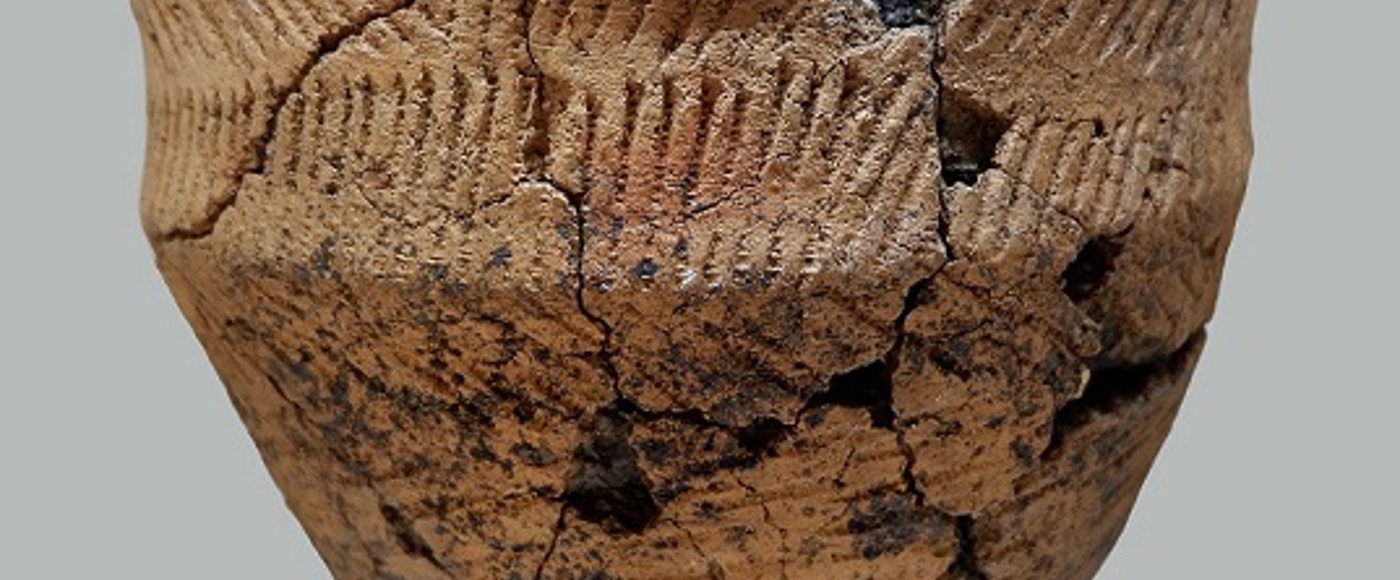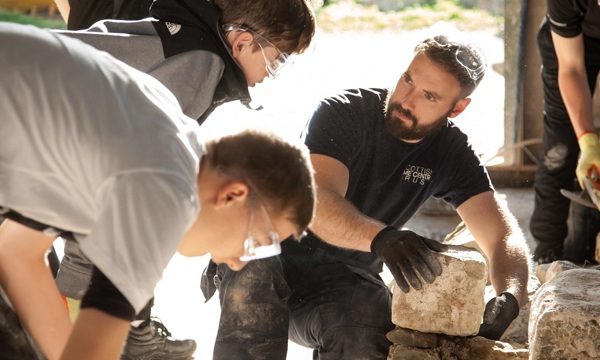A Bronze Age burial cist discovered at Kirkcaldy High Street in 1980, the last remaining thatched cottages in one of the Highland’s most famous villages and a Scottish archaeology club for young people are some of the latest projects set to benefit from funding from Historic Environment Scotland (HES).
£142,040 has been awarded to 11 heritage projects as part of the Historic Environment Support Fund, administered by HES. The work that the projects carry out will benefit communities throughout the country from Dumfries and Galloway to Argyll and Bute, Fife and the Highlands.

© Marta Innes
As part of the funding, the University of Glasgow will carry out post-excavation analysis and research on human remains, environmental samples and artefacts discovered as part of an excavation of Bronze Age cist burials at Kirkcaldy High Street in 1980. Findings from the analysis and research will be published and archived and a pop-up exhibition at Kirkcaldy Galleries will be launched to engage young people with archaeology.
In Argyll and Bute, a heritage trail will be created by the Morvern Heritage Society to tell the forgotten story of the Lochaline Sand Mine. The disused railway line will be brought back into use and a public footpath and interpretation boards will be installed along the route to celebrate and showcase the history of the mine and its impact on the local area.
The Clan Gregor Society SCIO have also been awarded £26,813 to conserve and preserve Medieval gravestones at Glenorchy Church. The 14th century stones will be repaired and displayed inside the A-listed church. Visitors will also be able to discover the history of the graveyards through interpretive panels which will be displayed.
A rethatching programme will be carried out on the Glencoe Folk Museum which comprises two early 18th century cottages. The cottages are the last remaining category B-listed cruck-framed heather-thatched cottages in Glencoe Village and are an important example of early Highland vernacular architecture, as well as supporting the use of traditional skills. Staff and volunteer training and community engagement workshops and events will also take place as part of the project.
Meanwhile, the Council for British Archaeology have been awarded £4,753 to develop an online Scottish Branch of the Young Archaeologists Club to engage 8-16-year-olds with archaeology, while the Perth & Kinross Heritage Trust will provide traditional skills training to disengaged youths and people from disadvantaged backgrounds.
The Historic Environment Support Fund is used to support a variety of one-off, heritage-related projects in Scotland and has been running since 2016, with over £1 million distributed since it was launched.
Amy Eastwood, Head of Grants at HES, said:
“Through the Historic Environment Support Fund, we aim to champion heritage projects that use the historic environment to make a positive difference in their local area.
Whether it’s engaging the public with the historic environment, restoring important buildings and structures, or providing the next generation, including volunteers with the opportunity to learn from and champion traditional skills, each project provides a whole host of benefits to local communities across Scotland.”
Culture Minister Neil Gray said:
“I’m delighted to see that the recipients of these grants will widen access to our historic environment through a variety of diverse and innovative projects – all of which demonstrate commitment to the Historic Environment Scotland vision of Heritage for All.
“The projects will offer many benefits to local communities such as building capacity for young archaeologists, delivering training in traditional skills to young people with barriers to employment and engaging with people from disadvantaged backgrounds such as those within the criminal justice system.”
The next application deadline for the Historic Environment Support Fund is Sunday 31 July 2022.
Funding has been awarded to the following projects:
Glencoe Folk Museum, Highlands: £30,000
To support a rethatching programme for the Glencoe Folk Museum which comprises two early 18th century cottages. The cottages, which are now combined, are the last remaining category B listed cruck-framed heather-thatched cottages in Glencoe village and are an important example of early Highland vernacular architecture. The re-thatching will include the implementation of regular monitoring and spot maintenance that will be carried out by trained staff and volunteers as well as staff training, community engagement and participation, workshops and participation events.
Clan Gregor Society SCIO, Argyll and Bute: £26,813
To conserve and preserve Medieval gravestones of the Loch Awe School in Glenorchy churchyard. The 14th century stones will be repaired before being relocated and displayed inside the A-listed church. Interpretative panels and materials will be displayed to explain the historical context, artistic origins and subsequent history. In the graveyard, replacement markers will be placed on the original stone locations.
Scottish Lime Centre Trust, Fife: £22,000
To provide subsidised education days for built environment students, outreach for school groups, technical seminars, contractor days and bursaries to enable more people from more diverse backgrounds can access their programme.
Perth and Kinross Heritage Trust, Perth and Kinross: £20,000
To provide traditional skills training for 50 members of the community including disengaged schoolchildren, disadvantaged youths and adults within the criminal justice system, to consider traditional building skills as a potential career path or assist them in their own projects. Participants will receive training in traditional masonry repair and lime repointing and will attend talks on the effect of climate change on traditional buildings. A traditional carpentry skills course will also be included.
The Whithorn Trust, Dumfries and Galloway: £9,084
To provide for young people with barriers to employment the opportunity to attend four traditional building skills courses. This is part of a wider project for the B listed former Old Town Hall in Whithorn to transform the hall into a heritage and conservation skills training centre.
The Society for the Protection of Ancient Buildings (SPAB), Aberdeenshire: £8,120
The SPAB Working Party are yearly training events in the form of a working party located in a different building and location. On each project SPAB Scotland also partners with a different organisation. This year in partnership with the Birse Community Trust the event will be held at historic Finzean Bucket Mill in Aberdeenshire. The 5-day event will involve expert craftspeople and volunteer teaching participants who offer a range of heritage craft skills. Training will be delivered this year in timber work, lime mortar mixing, roof and drainage repairs and vegetation clearance.
University of Glasgow, Glasgow: £7,472
To deliver a historic backlog publication including archiving of a HES-funded rescue excavation in 1980 of Bronze Age cist burials at Kirkcaldy High Street. A short programme of new post-excavation analysis and specialist research on the human remains, environmental samples and artefacts including food vessel and lithics will be carried out. A peer-reviewed journal will then address specific identified national research recommendations and will contribute to current debates on Bronze Age regionalism and identity. A pop-up exhibition at Kirkcaldy Galleries to engage young people will be launched, as well as public workshop events and the creation of new replicas to enhance future visitor experiences.
Morvern Heritage Society, Argyll and Bute: £5,028
For a project to create a heritage trail to tell the forgotten story of the Lochaline Sand Mine near Morvern which is the only underground sand mine in Europe. Opened during the Second World War to produce high quality glass for periscope lenses and gun sights, the mine had a huge impact on the social and economic landscape of Morvern.
Movern Heritage Society will bring the disused railway line back into use as a public footpath and install interpretation boards along the route to celebrate the history of the local mine and its social and economic impact on the local area.
Council for British Archaeology, nationwide: £4,753
To support the 12-month delivery phase to set up an online Scottish branch of the Young Archaeologists Club, which is the only UK wide club for 8-16-year-olds with an interest in archaeology. The project will work to establish the club through marketing and promotion as well as developing forms and policies and guidance and resources for members and their parents or guardians. Once up and running it is intended that the club should self-sustaining and run by volunteers.
Battle of Prestonpans (1745) Heritage Trust, East Lothian: £4,500
To support a project celebrating the 125-year anniversary of the opening of Prestonpans Town Hall which is currently used as a heritage centre. As part of the project, the 1897 opening of the Town Hall will be re-enacted and livestreamed in period costume, an exhibition will be created on how the local community worked the salt pans, coal mines and brickworks, and memories from the community including any photographs of the Town Hall will be captured. Following completion of the project, permanent display boards will be erected in the Town Hall as well as a digitally accessible publication.
The Society for the Protection of Ancient Buildings (SPAB), Perth and Kinross: £2,500
To support the Scottish Mills Weekend which was a new event bringing together the Scottish milling community at Lower City Mills in Perth for discussion, collaboration, learning and sharing. The event was a partnership between SPAB and Perth and Kinross Heritage Trust to encourage the wider Scottish milling community to work more collaboratively with the aim of forming a Scottish Millers’ Forum to raise the profile of Scottish mills’ heritage.
Glamis Cottage, Angus: £1,770
To carry out repairs and ongoing necessary maintenance to the thatched roof on the B-listed Glamis Cottage in Angus. The property is one of two known thatch buildings in the Angus Council area.
About Historic Environment Scotland (HES)
- We are the lead public body charged with caring for, protecting and promoting the historic environment. We will lead on delivering Scotland’s first strategy for the historic environment, Our Place in Time.
- Historic Scotland, Scran, Canmore, The National Collection of Aerial Photography (NCAP), The Engine Shed, Stirling Castle and Edinburgh Castle are sub-brands of HES.
- View our press pack and keep up to date by registering for media release email alerts. If you wish to unsubscribe, please contact us.
Follow Historic Environment Scotland
Twitter: @HistEnvScot | @welovehistory
Facebook: @HistoricEnvScotland | @VisitHistoricScotland
Instagram: @HistEnvScot | @historicscotland
For further information, please contact:
Stacey Shaw
Historic Environment Scotland Media Office
Mobile: 07221 959 962
communications@hes.scot

